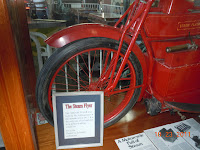 The beautifully restored Steam Flyer which is exhibited at Musee Mecanique at San Francisco's Fishermans Wharf is probably the best example today of the steam powered motorcycle era. If your travels include a San Francisco vacation or weekend trip into the city, going to the Musee Mystique and viewing this exhibit for yourself is very well worth your time. It's also free.
The beautifully restored Steam Flyer which is exhibited at Musee Mecanique at San Francisco's Fishermans Wharf is probably the best example today of the steam powered motorcycle era. If your travels include a San Francisco vacation or weekend trip into the city, going to the Musee Mystique and viewing this exhibit for yourself is very well worth your time. It's also free.During the latter 1800's and in the early 1900's there was quite a lot of experimenting with steam powered motorcycles. Steam was the power of choice for both steamboats and railroads so the natural thing to do was to try and apply this to motorcycles. It had been tried several times with the newly developing automobiles so it was certainly reasonable to adapt it to the motorcycle. Steam trains were a common sight. One difference however is that with the motorcycle, the rider/driver is essentially sitting atop a steam engine. While steam power was the power of choice during the 1800's, it was a technology under constant development. It's first use in the 1800's steamboats changed the way people traveled although there were many disasters with the big steamboat boilers of the mid 1800's. The first motorcycles developed were essentially bicycles with a power source other than your legs. The first known steam powered motorcycles were developed in France. The first was the 1867 Michaux-Perreaux steam velocipede. This occurred when when Pierre Michaux son Ernest Michaux added a small steam engine to one of his velocipedes. Adapting steam power to a bicycle did present some challenges although there were advantages over the internal combustion engine. One was that the steam engine was quieter. Also the fuel efficiency was better. It would also fit quite well into today's interest in green technology. The downside is that the rider would have to keep handy a good supply of oil and water.
The Steam Flyer that is exhibited at Musee Mecanique was built by a Sacramento California machinist by trade by the name of Niles Gillenwaters. This is certainly one of the best exhibits of vintage steam motorcycles. After using parts from a variety of sources, Niles Gillenwaters went to work in 1912 building his 550 pound Steam Flyer. While the motorcycle took several years for Gillenwaters to build he also spent years afterward making alterations. Through the years Niles Gillenwaters had several offers to purchase the machine, one being from the French Government but ultimately he sold it to Playland-at-the Beach amusement park in San Francisco. After that the machine found it's way to the close bySutro Baths museum. A sign was placed next to the display stating that it was the only steam powered motorcycle built in America which apparently however was not the case. The Steam Flyer was never put into production. There was only one built which is the one displayed at Musee Mecanique. I could not find any definitive speed records for the Steam Flyer although at the turn of the century steam motorcycles were thought to travel about 15 MPH and keep going about an hour before refilling the water. The engine has a watertube boiler and three cylinders. The Steam Flyer is still reported to be in good running condition.
 |
| Steam Flyer pressure gauge |
(Photos from author's private collection)


